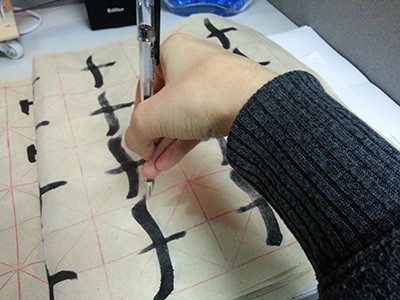It will only take [est_time] to read this post!
Written by Nora at WrittenChinese.Com
I guess when I first started learning Chinese, I disregarded 书法 (shū fǎ) or calligraphy as an integral part of the Chinese language. It seemed more like an old-school way to pass the time; something for old men to do in the wee hours of the morning, sipping tea in inky meditation. After being in China for quite some time, I began to get more and more curious about this art form but never gathered the courage to actually try it out. It seemed all too complicated- What paper should I buy? Where do you get the brushes and ink? Isn’t it expensive? Am I going to make a massive mess, give up the next day and throw all the materials into a box forevermore?

Then one day, we were doing a focus group in a local Shenzhen pub, trying to gather some information about where we can improve (PS. If you have ideas, please send them!), and a TV news crew happened to be there at the same pub. They were filming foreigners in Shenzhen and testing their Chinese language levels. When they got to me, we ended up having a relatively long conversation which led to them inviting me the next morning to do a short interview on Shenzhen TV and to try out Chinese calligraphy. I was a bit nervous to try it for the first time on camera, but I sucked it up and did it anyway. Here’s what happened:
If you’re in China, you can view it here on Youku.
In the video, you can see me with the 书法师 (shū fǎ shī) or calligraphy master trying my first attempt at writing with a brush and ink. Previously I had done some writing with a pencil on paper, but this was the first time I tried the real thing. If you didn’t catch what we were saying in the interview, they asked me questions about my life in China and about issues with foreign women dating Chinese men, kind of off-topic but I guess makes for interesting TV. Finally, they turned it over to the calligraphy teacher and he showed me the basics of holding a brush and how to write 我爱深圳 (wǒ ài shēn zhèn) or I love Shenzhen. (Which is true!)
I have made it my New Year’s resolution for 2015 to attend Chinese calligraphy classes with the same ShuFa master each week to learn Chinese calligraphy. If you’ve never learned Chinese calligraphy before, learn with me on my journey week by week and find out what Chinese calligraphy is all about and how it can help you learn Chinese.
I had my first lesson today and I’ll show you what I’ve learned. Go on, try it with me!
Holding the Brush and Paper
This is the most basic and most important part when learning Chinese calligraphy. I always thought I was supposed to hold the brush like I hold my pencil. This is how I would hold a pen or pencil, but this is not correct.
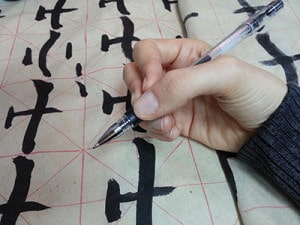
So instead, you should place the brush between your middle and ring finger, so that it is resting evenly with 2 fingers on either side (by the way, this is how you should hold the upper chopstick when eating).
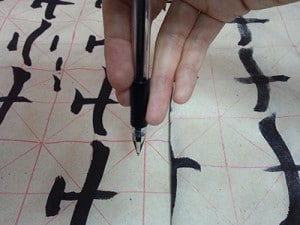
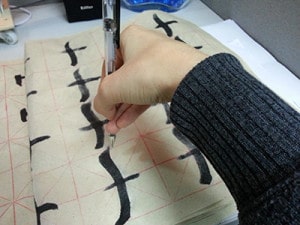
Finally, you should hold the brush vertically, so that it is always pointed in a straight line at the sky. Your free hand should be on the paper at all times, holding it steady as you write.
Creating Brush Strokes
This brings up the next most important point when learning Chinese calligraphy: the movement of the brush does not come from the fingers, it does not come from the wrist, it does not come from the elbow or the arm, it comes from the whole body. This follows the same holistic principals of Chinese philosophy and medicine. You must be one with the brush! So let’s start with the first task: getting control of the brush and drawing straight lines. The lines are straight, but they are not the same as drawing a straight line with a pen or pencil. Instead, when you first place the brush to the paper you move the brush slightly in the opposite direction before drawing the line.

Think of it like in a cartoon when a character gets ready to start running, he kind of winds up before moving forward.
Then when you finish, you back peddle slightly. Here is a pattern of how it should look:
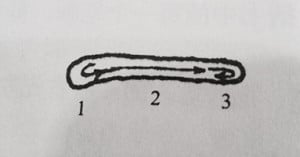
Though the lines appear simple, they should be written slowly and thoughtfully. The point is to begin learning to control the brush and the movement. Repeat these lines at least 20 times, until you feel confident that you have made the connection between your body and the paper.
Here’s my first try:

Now let’s try writing a simple character using what we’ve learned with the straight line. This straight horizontal line has a name, it’s called: 横 (héng). The character we are going to write has two of these plus a vertical line, which is called 竖 (shù). The vertical line does not hook at the top, but instead is drawn straight down and then hooks back upwards at the end. This character is 干 (gān) and means dry.
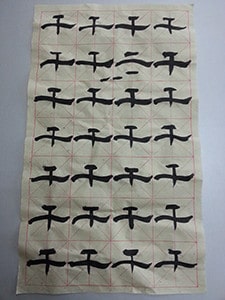
You now have all the tips needed to draw our first character. If you want to learn Chinese calligraphy like this, then you’ll need some stroke animations to follow. You can see stroke animations for almost every character on the Written Chinese Online Dictionary If you would like to learn more about the different strokes in Chinese characters, you can read this article, Chinese Character Stroke Rules.
Learn with me! Post your attempts at writing the following characters: 一 (yī) which means one, 二 (èr) which means two, 十 (shí) which means ten, and 干 (gān) which means dry. You can try it with any kind of paints if you don’t have access to traditional materials. Go on, don’t be shy!
